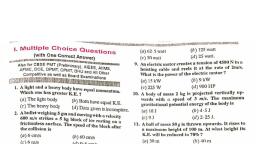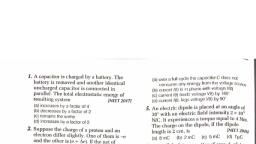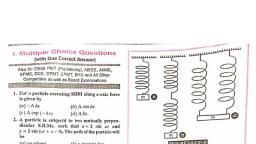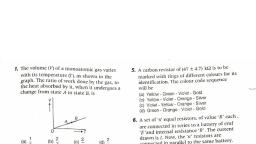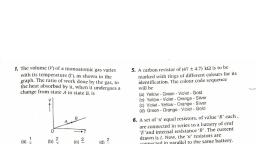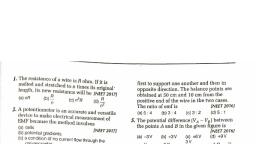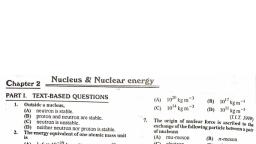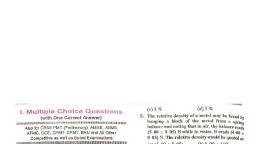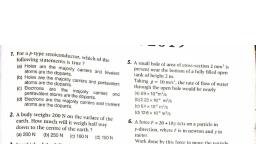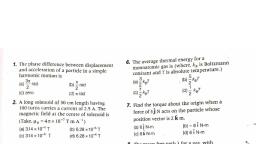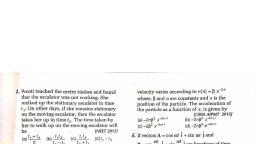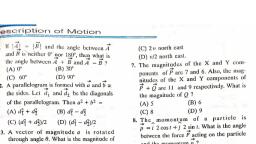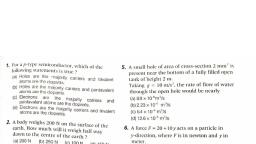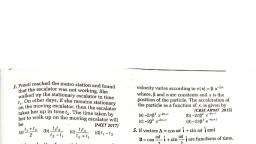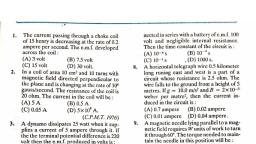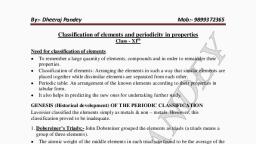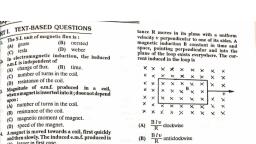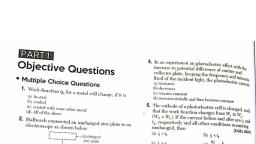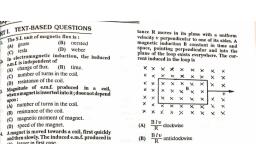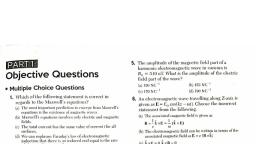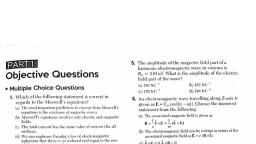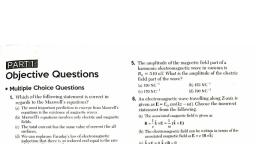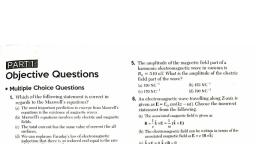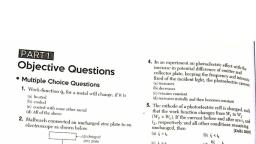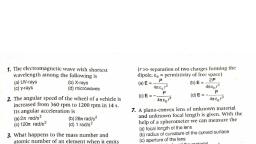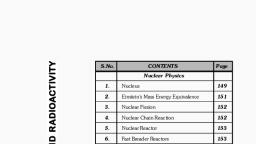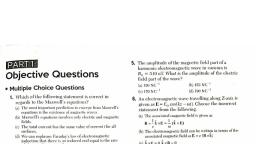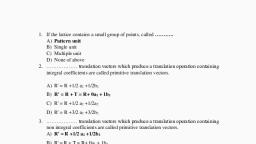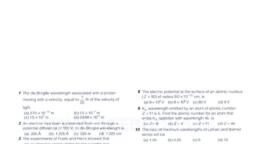Page 1 :
a, , iL, , I. TEXT-BASED Ques TIONS, The chemical behaviour of an, port, , ay the number of clectrons orbiting, ‘ its nucteus, WSL HOU, (yy the number of protons in the Nueleus, © the number of neutrons in the Nucleus,, o the number of nucleons in the, , stom depends, , Nucleus,, The ionic crystals are, (A) brittle,, (by made of positive ions in the ove, electrons, ean af, , © very hard., «(D) bound by weak electrostatic attraction., , Which of the following is not the property of the, ionic crystals ?, , (A) Good conductors, , (B) Strong but non-directional binding force, , (C) High melting point, , (D) High latent heat of fusion., , Solid CO, forms, , (A) ionic bonds,, , (B) vander Waals’ bonds., , (C) metallicbonds. (D) covalent bonds., (C.B.S.E. 1993), , Which of the following is not the property of, , covalent crystals ?, , (A) High melting point., , (B) Generally bad conductors., , {C) Exist in the form of individual molecules., (D) Insoluble in water., , Ina germanium crystal, the interatomic bonds, are, , (A) ionic (B) metallic, {C) vander Waals’ (D) Covalent., (Karnataka Entrance, 1992, 1991), , 10,, , 12., , 13., , Which of the following in not the property of, vorler Wily’ componnds ?, , (Ab Soluble in water, , (1) Low elvetrical conductivity, , (Cy High melting point, , (D) May be crystalline or no crystalline., Which one of the following in the weakest kind, of bonding in solids 2, , (A) tonic (By) Metallic, (C) vander Waals’ (D) covalent, (CBSE. 1992), , Which of the following types of the solids is, , opaque to visible light, when irradiated ?, , (A) bonic crystals (By) Metals., , (C) Covalent crystals, , (D) None of the above, , The binding forces in metallic erystals are, , (A) electrostatic forces of attraction,, , (B) vander waal’s forces of attraction,, , (C) magnetic forces. (D) covalent forces., , Metullic solids are always opaque, because, , (A) solids reflect the incident light., , (3) incident light is readily absorbed by free, electrons in metals., , (C) incident light is scattered by solid, molecules,, , (D) energy band traps the incident light., (Karnataka Entrance, 1993, 1991), , Metals are good conductors of heat than insulators, because, , (A) they contain free electrons., (B) their atoms are relatively far part., (C) thejr atoms collide frequently., (D) they have reflecting surface., (C.P.M.T, 1992), , Which of the following types of solids are, generally good optical reflectors ?
Page 2 :
14,, , 15,, , 16., , 17., , (A) Metals, , (C) lonic crystals, , The binding forces in a metallic crystal are, , (A) electrostatic forces of attraction., , (B) vander Waals’ forces of attraction., , (C) magnetic forces., , (D) covalent bond forces., (Pre-Medical/Dental 1990), , Which of the following is not the property of, metallic bonds ?, , (A) Made of ions in the ocean of electrons, (B), {C) Good conductors, , (D) May be hard or soft., , in yood conductors of electricity, the type of, bonding that exists is, , (B) Covalent crystals, , Insulators, , (A) ionic (B) covalent, (C) metallic (D) vander waals, (C.B.S.E. 1995), , Which of the following metals is liquid at, 30°C 2?, , (A) Tin, (C) Bismuth, , (B) Mercury, (D) Cesium, (4.F.M.C. 1997, , 1 LVUL, il), , PART II. THOUGHT-BASED QUESTIONs, , 18., , 19., , 20., , 21., , Diamond is very hard, because, , (A) itis a covalent bond,, , (B) it has large cohesive energy., , (C) it has high melting point., , (D) itis insoluble in all solvents,, (Pre-Medical/Dental 1997, , A solid that is transparent to visible light ‘a, , conducts only at higher temperatures formedy, (A) vander Waals’ bonds., , (B) covalent bonds. (C), (D) metallic bonds., Asolid that is opaque to visible light and Whose, electrical conductivity increases with tempera., ture is formed by, , (A) ionic binding., , (B) vander Waals’ binding., , (C) covalent binding. (D) metallic binding., Asolid that is opaque to visible light and whose, electrical conductivity decreases with tempera., ture is formed by, , (A) ionic binding ., , (B) vander Waals’ binding., , (C) covalent binding., , (D) metallic binding., , tonic bonds,
Page 3 :
22., , 23., , 25., , 27., , 28., , 29., , SO ee |, , x nucleus , Y™ emits one a and twof-particles., he resulting nucleus is, , (A), ~2X" = (B) ane, (©) n-aX™" 4 Dy) x", (C.B.S.E. 1998), , The radioactive nucleus 28 emits an a, particle and the daughter nucleus a f-particle., , The charge number and the mass of the final, nucleus are, , (A) 91,234 (B) 92,234, , (C) 90, 234 (D) 93,234, , After one a and two f-emissions :, , (A) mass number reduces by 2., , (B) mass number reduces by 4., , (C) mass number reduces by 6., , (D) atomic number remains unchanged., (C.B.S.E. 1999), , What is the respective number of a and f particles emitted in the following radio-active, decay ?, , x — are, , (A) 6and8 (B) 6and6, (Cc) 8and8 (D) 8and6., (C.B.S.E. 1995), , The halflife of 1%! is $ days. Given a sample of, , !*! at time ¢ = 0, we can assert that, (A) no nucleus will decay before ¢ = 4 days., , (B) no nucleus will decay before ¢ = 8 days., , (C) all nuclei will decay before 1 = 16 days., , (D) agivennucleus may decay at ye! time after, 1=0. (LLT. 1998), , In which radioactive disintegration, a neutron, , is dissociated into a proton and an electron ", , (A) Het* emission. (B) B-emission., , (C) _ y-emission., , (D) positron emission. (A.F.M.C. 1995), , Half-life ofa radioactive element depends upon, , (A) the amcunt of element present., , (B) temperature., , (C) pressire., , (D) nature of material., , (A.F.M.C. 1996 ; N.CE.RT. 1978), Aradioactive sample with a balf life of 1 moot, has the label : ‘Activity = 2/#e1on.1 8-09!", What was its activity two months ©
Page 4 :
31., , 32., , 33,, , 37., , (A), (c), , LO pec, 4 pei, , (By, ip), , OFS peed, Byci, , (C.BS.E, 1992), The decay constant of radioactive element, radium is 4°28 x 107 year”! Its half life will, La, (A) 2000) years, (C) 63 yeurs, , (B), a), , 1240 years, 1620 years, (A.F.M.C, 1998), If 10% of a radioactive material decays in, § days, then the amount of original material, left after 20 day is approximately :, (A) 60% (B) 65%, (C) 70% (D) 75%, (A.F.M.C, 1998), , Ifthe halflife period of a radioactive substance, is 225'8 min, then the value of the decay constant is, (A) 31x 1073 min),, (B) 3-1 1074 min“., (C) 3-1x 107° min™!,, (D) 3-1 107? min™?., , (C.B.S.E. 1999 ; A.F.M.C. 1997), Half lives of two radioactive substances A and, B are 20 min and 40 min respectively. Initially,, the samples of A and B have equal number of, nuclei. After 80 min, the ratio of remaining, number of A and B nuclei is, (A) 1:16 (B) 1:4, , (cy 1:1 (D) 4:1, (C.BS.E. 1998), , Aradioactive element has half-life period 1600, years, After 6400 years, what amount will, , remain ?, ®) 7, 1, , O) |, , (CBSE. 1993), , After a time equal to five half lives, the amount of, radioactive material remaining undecayed is =, (A) 20% (B) 10%, , (C) 5% (D) 3%, (A.F.M.C. 1996; N.CE.R-T. 1990), , ‘The counting rate observed from a yadioactive, source atf = 0 was 1600 counts s andat, 1 = 8s, itwas 100 counts s7!. The counting rate, (counts s~') observed at ¢ = 6s will be, , (A) 400 (B) 300, , (D) 150, me (M.N.R. 1991), , of a Geiger Muller counter for, the radioactive material of half, , asestoSs ! after? hours. The, , (A), , ©, , nie, , The count rate, the radiation of, , 41., , 42., , 43., , 45., , sony, 2087!, , (A) (hy 2507!, (cy 8097! (Dy 625 5°!, = (AL MLC. 1997 CSE, The half life of radiouctive radon is 4 tee, ‘The time at the end of which Hith of the shag, sample will 7 |, os ~o-4aa undecayed ix (tive, (A) 13-8 days (B) 16-4 days, (C) 33 days (D) 76 days,, (LLT, 198), , Ifthe decay constant ofa radioactive sy, isd, then its half-life —, fe 1 fe and mean life are respec., , 1 lou, 2 7, (ay and — (ny 182 f 2 ana, , —, , : 1 A, (C) A log, 2nd > (D) Tog, 2 >, (M.N.R, 1990 ; L1.T. 1989), , The halflife of « radioactive substance as com., red to its mean life is, (A) smaller and 69-34%., , (B) smaller and 30-7%., (C) larger and 30-7%., (D) larger and 69-3%. (CET. 1998), , Beta rays emitted by a radioactive material are, (A) electromagnetic radiations., (B) the electrons orbiting around the nucleus., (C) charged particles emitted by nucicus., (D) neutral particles. (LLT. 1983), Neutrino is a particle with, (A) chargeless property and has no spin., G8) chargeless property and has spin., (C) charged like electron and has spin., (D) the same as‘neutron., , (Karnataka Entrance, 1993, The nucleus of aca, after two successive, B™- decays will give, , (A) ggPall (B) goin!", (©) sSa!? (D) so8nl"8, (CBSE. 1992, , The nucleus ¢C™? absorbs an energetit, neutron and emits a f-particle. The resull, nucleus is, , (ay Ni ) sb", , ni3 wo) <c?, ~ (CBSE 19, A positron has the same mass 2S i, (A) proton (B) on™, (C) neutron (D) EMC 1993), , In the nuclear reaction = ‘, cl wl apt +X, , what does X stand for?
